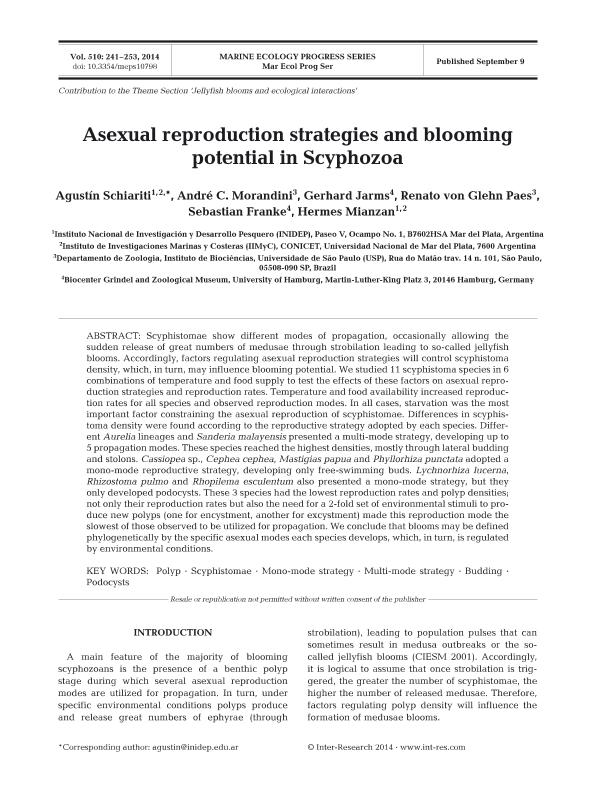Mostrar el registro sencillo del ítem
dc.contributor.author
Schiariti, Agustin

dc.contributor.author
Morandini, André C.
dc.contributor.author
Jarms, Gerhard
dc.contributor.author
von Glehn Paes, Renato
dc.contributor.author
Franke, Sebastian
dc.contributor.author
Mianzan, Hermes Walter

dc.date.available
2020-03-30T13:29:41Z
dc.date.issued
2014-09
dc.identifier.citation
Schiariti, Agustin; Morandini, André C.; Jarms, Gerhard; von Glehn Paes, Renato; Franke, Sebastian; et al.; Asexual reproduction strategies and blooming potential in Scyphozoa; Inter-Research; Marine Ecology Progress Series; 510; 9-2014; 241-253
dc.identifier.issn
0171-8630
dc.identifier.uri
http://hdl.handle.net/11336/101241
dc.description.abstract
Scyphistomae show different modes of propagation, occasionally allowing the sudden release of great numbers of medusae through strobilation leading to so-called jellyfish blooms. Accordingly, factors regulating asexual reproduction strategies will control scyphistoma density, which, in turn, may influence blooming potential. We studied 11 scyphistoma species in 6 combinations of temperature and food supply to test the effects of these factors on asexual reproduction strategies and reproduction rates. Temperature and food availability increased reproduction rates for all species and observed reproduction modes. In all cases, starvation was the most important factor constraining the asexual reproduction of scyphistomae. Differences in scyphistoma density were found according to the reproductive strategy adopted by each species. Different Aurelia lineages and Sanderia malayensis presented a multi-mode strategy, developing up to 5 propagation modes. These species reached the highest densities, mostly through lateral budding and stolons. Cassiopea sp., Cephea cephea, Mastigias papua and Phyllorhiza punctata adopted a mono-mode reproductive strategy, developing only free-swimming buds. Lychnorhiza lucerna, Rhizostoma pulmo and Rhopilema esculentum also presented a mono-mode strategy, but they only developed podocysts. These 3 species had the lowest reproduction rates and polyp densities; not only their reproduction rates but also the need for a 2-fold set of environmental stimuli to produce new polyps (one for encystment, another for excystment) made this reproduction mode the slowest of those observed to be utilized for propagation. We conclude that blooms may be defined phylogenetically by the specific asexual modes each species develops, which, in turn, is regulated by environmental conditions
dc.format
application/pdf
dc.language.iso
eng
dc.publisher
Inter-Research

dc.rights
info:eu-repo/semantics/openAccess
dc.rights.uri
https://creativecommons.org/licenses/by-nc-sa/2.5/ar/
dc.subject
POLYPS
dc.subject
SCYPHISTOMAE
dc.subject
MONO-MODE STRATEGY
dc.subject
MULTI-MODE STRATEGY
dc.subject
BUDDING
dc.subject
PODOCYSTS
dc.subject.classification
Ecología

dc.subject.classification
Ciencias Biológicas

dc.subject.classification
CIENCIAS NATURALES Y EXACTAS

dc.title
Asexual reproduction strategies and blooming potential in Scyphozoa
dc.type
info:eu-repo/semantics/article
dc.type
info:ar-repo/semantics/artículo
dc.type
info:eu-repo/semantics/publishedVersion
dc.date.updated
2020-03-12T15:20:10Z
dc.journal.volume
510
dc.journal.pagination
241-253
dc.journal.pais
Alemania

dc.journal.ciudad
Oldendorf
dc.description.fil
Fil: Schiariti, Agustin. Instituto Nacional de Investigaciones y Desarrollo Pesquero; Argentina. Consejo Nacional de Investigaciones Científicas y Técnicas. Centro Científico Tecnológico Conicet - Mar del Plata. Instituto de Investigaciones Marinas y Costeras. Universidad Nacional de Mar del Plata. Facultad de Ciencias Exactas y Naturales. Instituto de Investigaciones Marinas y Costeras; Argentina
dc.description.fil
Fil: Morandini, André C.. Universidade de Sao Paulo; Brasil
dc.description.fil
Fil: Jarms, Gerhard. Universitat Hamburg; Alemania
dc.description.fil
Fil: von Glehn Paes, Renato. Universidade de Sao Paulo; Brasil
dc.description.fil
Fil: Franke, Sebastian. Universitat Hamburg; Alemania
dc.description.fil
Fil: Mianzan, Hermes Walter. Consejo Nacional de Investigaciones Científicas y Técnicas. Centro Científico Tecnológico Conicet - Mar del Plata. Instituto de Investigaciones Marinas y Costeras. Universidad Nacional de Mar del Plata. Facultad de Ciencias Exactas y Naturales. Instituto de Investigaciones Marinas y Costeras; Argentina. Instituto Nacional de Investigaciones y Desarrollo Pesquero; Argentina
dc.journal.title
Marine Ecology Progress Series

dc.relation.alternativeid
info:eu-repo/semantics/altIdentifier/doi/http://dx.doi.org/10.3354/meps10798
dc.relation.alternativeid
info:eu-repo/semantics/altIdentifier/url/http://www.int-res.com/abstracts/meps/v510/p241-253/
Archivos asociados
